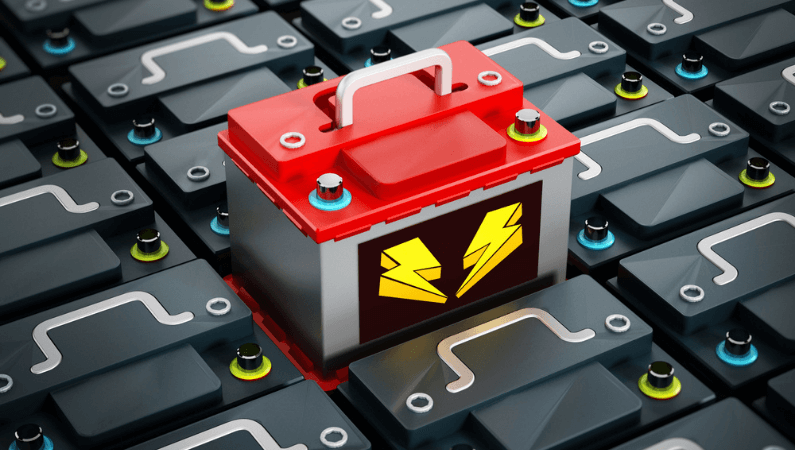Saltwater Battery: The Safest Long-Term Storage Solution
Energy storage systems used for solar power and other renewable energies are no longer restricted to a niche market. While lithium-ion and lead-acid batteries are mature technologies, people look for other reliable alternatives. This provides an excellent opportunity for saltwater battery technology with its potential to positively impact the energy storage market.
This technology uses a water based electrolyte that is non-toxic and therefore much safer to use and with almost zero impact to the environment.
While there is great potential in saltwater batteries for applications in the energy storage market, it does not mean that saltwater batteries will replace lithium-ion batteries for portable devices anytime soon. These batteries have a lower energy density than lithium-ion batteries and require more space to provide the same amount of power. Therefore, they have a larger scale focus.
Saltwater battery technology is becoming more and more popular as people look for safer energy systems that do not require maintenance and are safer in general. In this article, we will dive into saltwater battery technology, its advantages and disadvantages, and everything you need to know about them.
Contents
- What Are Saltwater Batteries and How Are They Different?
- What Are the Main Advantages and Disadvantages of Saltwater Batteries?
- Saltwater Batteries vs. Lithium-Ion Batteries: What Do You Need to Know?
- How to Make a Saltwater Battery at Home
- Commercialization of Saltwater Batteries: Are We Getting There?
- Conclusion
What Are Saltwater Batteries and How Are They Different?

Before heading into the energy storage applications of saltwater batteries, it is important to understand the basics of how they work and how they differentiate from other options.
Understanding the Basic Principle of Batteries
On the most basic level, saltwater batteries function as any other type of battery. These are energy blocks consisting of an anode and a cathode to work as the positive/negative terminals, using an electrolyte to exchange ions in one direction or the other, depending on whether the battery is being charged or discharged.
In the example of lithium-ion batteries, the anode is made of graphite, and the cathode out of lithium is made of metal oxide. These batteries have a separator preventing the anode and cathode from touching each other and causing explosions, but still, this does not make them 100% safe since they have been known to malfunction.
How Are Saltwater Batteries Different from Others?
The main difference between saltwater batteries from others like lithium-ion or lead-acid lies in the chemical core of the battery. This battery uses saltwater produced from seawater as its electrolyte solution, which is how it gets its name. This allows for sodium to be the main conductor, being a much safer option than the lithium-ion or lithium iron phosphate option.
Unlike traditional batteries, saltwater battery technology does not require preventive maintenance. Moreover, these batteries are not manufactured using hazardous or toxic materials, which is why they will not present any danger of explosion or release chemical gases toxic for humans.
The lack of hazardous chemicals in the manufacturing of saltwater batteries does not only make them safer but ensures they can be fully discharged without damaging the battery.
What Are the Main Advantages and Disadvantages of Saltwater Batteries?

There are several advantages and disadvantages of using a saltwater battery as the main option for your energy storage system when paired with solar panels or other renewable energies.
Advantages
Here are the advantages of using saltwater batteries.
1. They Are Safer & Less Toxic
Few of the retail batteries installed in solar power battery banks have a 100% fire safety guarantee, especially since most use harmful materials that could be explosive. Saltwater greatly excels in this category because they contain saltwater within their energy cells making them nonflammable and nonexplosive.
2. Easier to Recycle
The amazing news for the environment is that saltwater batteries are much easier to recycle. The manufacturing process for saltwater batteries does not involve any heavy metals nor toxic materials, meaning they can be easily disposed of and recycled after they have ended their life span. They are also environmentally friendly at the time to manufacture since they do not need the extraction of heavy metals.
3. Longer Life Span
Saltwater batteries can hold around 5,000 cycles and can be used beyond their indicated cycles without risks. This grants saltwater batteries a longer life span and makes them perfect to couple with solar panels in general. The long life span also avoids the need to replace batteries in the mid-term of a project as would happen with lead-acid batteries.
4. Maximum Depth of Discharge Performance
While fully discharging regular batteries can harm their life span and end up requiring maintenance, this is not the case for saltwater batteries. These can be fully discharged and endure long periods without energy in their battery cells, without reducing their life span or damaging their components.
5. No Overheating
An important feature is that it is impossible that the battery overheats since its electrolyte solution is mainly composed of water. This means that there is no internal chemical interaction that can go above the 212ºF since that would evaporate all the water contained inside and lead to an open-circuit scenario.
Disadvantages
Here are the disadvantages of using saltwater batteries.
1. Manufacturing Costs
The large-scale manufacturing processes used to produce lithium-ion batteries have been steadily reducing prices over the years. With saltwater battery technology being relatively new, there’s progress yet to be made for large-scale production of batteries that ensure lower cost for saltwater batteries over time.
2. Lower Energy Density
One of the main limitations of saltwater batteries is their size. These have a lower energy density and therefore do not store as much power in the same volume as a lithium-ion or lead-acid battery. At the current stage of technology, saltwater batteries require a much larger space to provide the same energy storage capacity as common battery banks do for renewable energy systems.
Saltwater Batteries vs. Lithium-Ion Batteries: What Do You Need to Know?
Saltwater batteries are very different from lithium-ion batteries. While both of them follow the same basic principle for a battery, they are manufactured using different electrolytes and conductors, resulting in a whole different chemistry for both batteries.
Lithium batteries use lithium salts as an electrolyte, which can be a hazardous and flammable substance. The saltwater battery uses a seawater solution as an electrolyte, making it completely fire-safe.
The biggest difference between lithium-ion and saltwater batteries is their size and energy density. Lithium batteries have high energy density and hold higher charges within their energy cells, while saltwater batteries have lower energy density and store much less power in a battery of the same size. Considering the safety of saltwater batteries, if space is not an issue, these batteries could be reliable for solar-powered homes in the long run.
Another difference between both technologies is the price. Mass production of lithium-ion batteries caused manufacturing prices to fall exponentially. The industry is just starting to experiment with saltwater technology, and its manufacturing prices are still too high. Lithium batteries are here to stay, but there is a good market size that saltwater batteries could take, especially in commercial or industrial applications where safety control parameters are crucial.
How to Make a Saltwater Battery at Home

To understand the effectiveness of saltwater as an electrolyte, you can do a DIY rechargeable saltwater battery. This is a simple science project where you will learn how to make a saltwater battery and power a 15V bulb or anything with similar voltage.
You will need the following items:
- 20 baby food jars
- 20 galvanized nails (3–4’’ long)
- 260’’ of #12 copper wire (you can cut the wire into 20 equally long 18’’ copper wires)
- A 10.5’’ x 13’’ plywood piece (or some other type of wood)
- Pencil
- Rule squad
- Power drill
- Wood rod
- Water
- Sodium table salt or Epsom salt
- Multimeter
- 15V LED bulb
Method to Make a DIY Rechargeable Saltwater Battery
After preparing the materials you need to create your own rechargeable saltwater battery, follow these simple instructions below.
1. Prepare the Setup
The first step in the DIY rechargeable saltwater battery is placing the food jars on top of the plywood and marking the square spaces for each jar with a rule squad and a pencil. The 10.5’’ x 13’’ plywood will get you a 4 x 5 array of jars, but you can change the size to customize your DIY rechargeable saltwater battery.
In each square, draw two marks with some distance from each other, using a ruler to line up the markings. These will be the anode and cathode of each cell. Since we need to do a series connection for each cell to the next one, you must connect the cathode of a cell to the anode of the next one (positive–negative connections) from start to end.
2. Drilling and Connecting
After the markings are done, you need to drill a hole into each one. Here, you will place the copper wires for the cathodes and the galvanized nails for the anodes, so make proper sizes for the holes.
Make coils from the copper wires by curling them around a small cylinder like the wood rod used in home brooms. You should leave 4–5” without curling to use in the connection of the battery cells.
Fit each nail in its hole, and check that it fits into a jar with enough space for the cathode. Then, insert the coils from below the plywood to set them at the same height as the nails. Bend the copper wires up the plywood by curling them around the nail of the next cell. Each cell should be connected from the cathode (copper wire) of a cell to the anode (nail) of the next one. In the end, you will have one free anode and cathode at each corner, being the positive–negative terminals of your DIY rechargeable saltwater battery.
3. Add Saltwater Mixture
Last but not least, pour in the water and salt. The perfect Epsom salt-to-water ratio for battery is 2.5 tablespoons of salt per liter of water. When using sodium table salt, add 6 tablespoons for each liter of water, filling each jar to the brim. Next, sit the plywood with anodes and cathodes on top of the filled jars, and check that each cell has one of each inside.
4. Test It!
Now, it is time to test your DIY rechargeable saltwater battery. Plug a solar panel or a solar battery charger, and see how the nails start to bubble as the battery cells charge. When time passes, the cells will turn green because of the copper wire.
After being charged, measure the voltage with the multimeter. If everything checks out, plug the 15V bulb, and enjoy hours of renewable energy in the saltwater battery you made.
Commercialization of Saltwater Batteries: Are We Getting There?
As much potential as saltwater batteries have, only one company has deeply ventured into the process of manufacturing and commercializing them: Aquion Energy. We will tell you a little bit more about them and what they mean for the saltwater battery industry.
Aquion Energy, Products, and Trajectory
Aquion Energy is a company founded in 2008 by Jay F. Whitacre and Ted Wiley. The company branded its saltwater battery product with the Aqueous Hybrid Ion (AHI) battery, a 100% safe battery that is nonflammable and nonexplosive. This company received funding from popular investing companies like Kleiner Perkins, Advanced Technology Ventures, and even Bill Gates.
Among the Aquion saltwater battery options, one of the most popular ones was the Aspen 48S, a 2.5 kWh battery stack with a 100% depth-of-discharge capability and a lifespan of around 3,000 cycles. Another popular product was the Aquion S30-0080 battery, a 2.6 kWh battery with similar specifications to the aspen 48S and a long-duration cycle of a 4–20h discharge.
By having a large-size battery with lower energy density than other options and high manufacturing costs, saltwater batteries presented an inconvenience that became obvious for the company. This is why in 2017, Aquion Energy voluntarily declared bankruptcy. Later that year, the company was acquired by Juline-Titans LLC and headed into the future looking to further develop its saltwater battery options.
The Biggest Saltwater Installation Project to Date
In 2017, Aquion Energy signed a contract for a massive storage system in Japan using a saltwater battery in the EIWAT Storage I project. This is a storage system installed in the Kagoshima Prefecture located in Kyushu Island, featuring a 122kWh Aquion saltwater battery, also known as the Aspen 48M-25.9 battery. This saltwater battery was powered by a solar array provided by Schneider Electric.
The Aspen 48M-25.9 battery has an impressive 100% depth of discharge and a life span of 3,000 cycles with a 70% retained capacity. Due to its technology, this battery cannot overheat or explode, making it 100% safe. Its internal core could reach a maximum temperature of 212ºF, the point at which the water would evaporate and the battery circuit would open.
The core of the battery was manufactured with an aqueous hybrid ion chemistry of a saltwater electrolyte. Its cathode and anode were made of manganese oxide and carbon titanium phosphate, respectively, with a synthetic cotton separator.
Conclusion
Are saltwater batteries the answer for the future of renewable energy storage?
Saltwater technology is quite impressive, and there is no denying it. These batteries are better for the environment, much safer for renewable energy storage systems, and even have a longer life span with little to no maintenance.
Even if saltwater batteries become more popular and manufacturing prices fall, lithium-ion technology is still a better technology for residential storage solutions due to its high energy density.
The saltwater batteries still have a long way to go. These are quite impressive, much safer, and have practical applications nowadays, but the industry needs to experiment further with the technology and solve some technical issues. Saltwater battery price still needs to be reduced, and perhaps researchers could even find a way to increase its energy density without sacrificing its safety, making it a stronger rival for lead-acid or nickel-type batteries.

Do you have kits or materials one can purchase for customers to build these batteries on sites where power density is a not an issue and will be stationary ?
Where can I buy a saltwater battery in South Africa?
How can I buy a Saltwater battery?
Do you have a distributor or reseller in South East Asia region?
Just a thought 55 gallon plastic barrel for a cell container 2.5 volts x 96 barrels 240 volts this would be 1800 square feet of storage space .
Hey there Danny Brown…I am beyond curious how your system has worked out for you? We are looking to do something quite similar on a large scale. What did you use for anode and cathode? How much salt per 55 gallon barrel and does it need to be epsom or mineral or kosher? Did the water have to be distilled? my email is gottahavefaith@rocketmail.com if that is easier. Thanks vey kindly
Sorry for jumping in, but did you find out if a single cell produces 2.5 volts? And can multiple sets of electrodes be immersed in the same cell if they are wired in parallel like the individual cells in a lead – acid battery?
Yes, just from basic electrical engineering multiple electrode sets can go in the same container if you wire them in parallel – that’s basically just “using bigger electrodes.” You can’t connect them in series, though – for that you need isolated containers.
Any special charge requirements needed? Can it be overcharged. Min max current needed
Hello, my name is Archer,
I am starting a crowdfunding campaign to bring a green generator I developed to market. I would like to offer my donors incentives for particular donations. I have done extensive research and have determined that saltwater batteries are cleaner and more reliable, I believe they’re superior and more sustainable. And what I’ve come to understand is that yours are the best to be had. I would like to ask if I could offer a limited amount of promo codes that could be applied to your products. I believe my donors would be interested in partnering my generator with your products. I believe either way it will draw more business to you. Please let me know if this is at all possible. I’m open to all suggestions and ideas and completely willing to discuss compensation. Thank you for your time.
Good day, I am wondering if the water needs to be distilled? I am guessing yes as rechargeable ones use distilled. Will the nails or copper erode after time in salt water? What does this charge out at, a 12 volt? Thank you very much.
I’m assuming that the bubbles coming from the anode and cathode are hydrogen and oxygen? How are these gases dealt with in a safe way?
Very interesting. I have been looking for extremely detailed instructions for a beginner who doesn’t understand this stuff at all. No luck. I have several acres and would like to build one that has 900 kwh or so using 55 gallon plastic drums.
Hi, we have a 8.1 kwh saltwater storage Greenrock from Bluesky Austria for 2 years. At the moment we are experiencing problems. The batteries charge fully very quick but discharge during the night to 20 % load although we use very little electricity (between 3 and 5 A measured on the DC side). Can you help us with any advice to get the batteries back to fully functioning. They came with 15 years life span, so this cannot be normal.
Please provide detailed instructions on how to dismantle Aquion battery stacks in order to recycle all the parts. I have separated all the cells in the stack and need to empty the cells. The ‘plug’ on the cells has a message engraved in it: Do Not Open. In English and German. What happens if I open it? Is there a way to empty the cells without opening this plug? It appears to be a threaded plug.